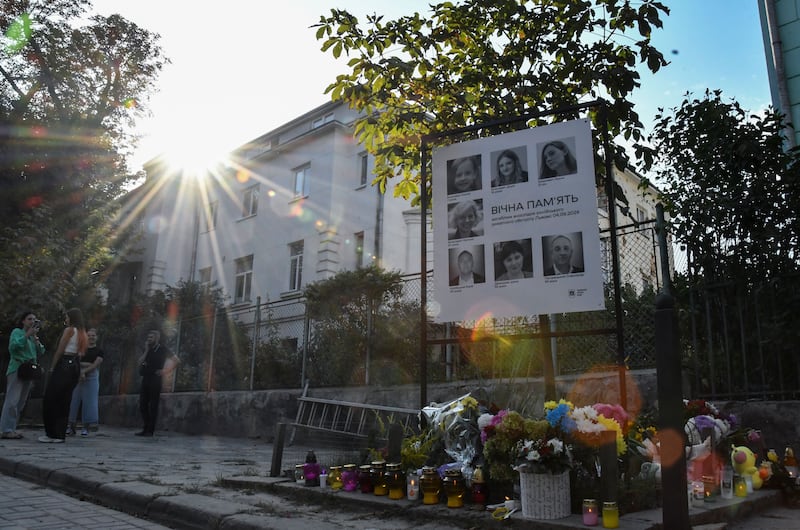Ukraine has achieved “a lot” in its Kursk offensive into Russia but it is hard to say how the situation will develop next, Nato secretary general Jens Stoltenberg told reporters in Oslo on Thursday.
“Only the Ukrainians can make the difficult choices that are needed, such as where to deploy their forces and what type of warfare is appropriate in this situation,” Mr Stoltenberg said.
Russian forces are advancing in the east of Ukraine while Ukrainian troops have made a bold incursion into Russia’s Kursk region, where it on August 6th launched the biggest foreign attack on Russia since the second World War.
Mr Stoltenberg said Ukraine has the right to self-defence, including with long-range missiles that can reach military targets on Russian territory.
“I am glad that many Nato countries have given that opportunity, and those that still have restrictions have softened the restrictions so that Ukraine can defend itself,” Mr Stoltenberg said.
Ukraine’s top military commander said in an interview broadcast on Thursday that the incursion into the Kursk region was working and that there had been no Russian advances on a key sector of the eastern front for six days.
“Over the last six days, the enemy hasn’t advanced a single metre in the Pokrovsk direction. In other words, our strategy is working,” Oleksandr Syrskyi told CNN in an interview. He said the military had also noted a decreasing in shelling and the intensity of the Russian offensive in other sectors.
Ukraine’s president Volodymyr Zelenskiy will on Friday attend a meeting of the Ramstein group, a coalition of nations supplying arms to Ukraine, where he is expected to ask for increased weapons deliveries, specifically long-range missiles, according to German magazine Spiegel.
Mr Zelenskiy has called on allies to assist with air defences and remove restrictions preventing Kyiv from using donated weapons for long-range strikes into Russia.
Mr Stoltenberg earlier told a conference he does not see any immediate military threat against Nato countries but said there was a constant danger of terrorism, cyber attacks and sabotage.

Meanwhile, the death toll from a Russian missile strike on a military institute in the east central Ukrainian town of Poltava on Tuesday rose to 55 as the rescue operation was completed, the emergency service said on Thursday.
Moscow’s troops hit the educational facility with two extremely hard-to-intercept ballistic missiles, and the Ukrainian officials said people barely had time to seek shelter.
The deadliest single attack of this year wounded 328 others, the emergency service added on the Telegram messaging app. Regional governor Filip Pronin said 27 people were in intensive care.
The rescue operation continued for three days but had to be stopped due to new air raid alerts, officials said. Experts were now working to identify bodies’ remains.
Russia’s defence ministry said the strike targeted soldiers and foreign instructors.
Ukraine’s land forces said that military personnel had been killed in the strike but did not provide details.
Moscow’s troops stepped up missile strikes on Ukraine in recent weeks attacking energy infrastructure and civilian facilities.
The day after the deadly Poltava attack, Russian drones and missiles hit the Ukrainian western city of Lviv, close to the border with Nato member Poland. Seven people were killed, including four from the same family. Elsewhere, one civilian was reportedly killed following Ukrainian shelling on the town of Shebekino in Russia’s southern Belgorod region on Thursday.
Meanwhile. the US has charged five Russian intelligence officials and a Russian civilian with conspiring to launch cyberattacks against Ukraine and its allies.
The Justice Department said a cyber unit of Russia’s military intelligence agency conducted “large-scale cyber operations” starting as far back as 2020, before Russia’s February 2022 invasion of Ukraine.
The move comes a day after the US took several legal actions against Russia to combat alleged efforts to meddle in the 2024 US presidential elections, including charging two employees of the Russian state media network RT and sanctioning RT and its top network editor.
Additionally on Thursday, Poland backed away from earlier claims that a drone had likely entered its airspace during a Russian attack on Ukraine in August, after a 10-day analysis and search for the object produced no results.
The Nato member has been on high alert for possible incursions on its airspace resulting from Russian attacks on neighbouring Ukraine, and the announcement that an object thought to be a drone appeared on radars on August 26th raised questions as to why it had not been shot down.
At the time the army said that weather conditions meant the object couldn’t be identified with complete certainty, meaning that shooting it down could have risked hitting a civilian target such as a light aircraft.
However, after an extensive search failed to find any trace of a Russian drone, general Maciej Klisz said: “as a result of the analytical activities undertaken, I currently state that with a very high probability there was no violation of the airspace of the Republic of Poland on August 26th” he told reporters. – Reuters
(c) Copyright Thomson Reuters 2024












